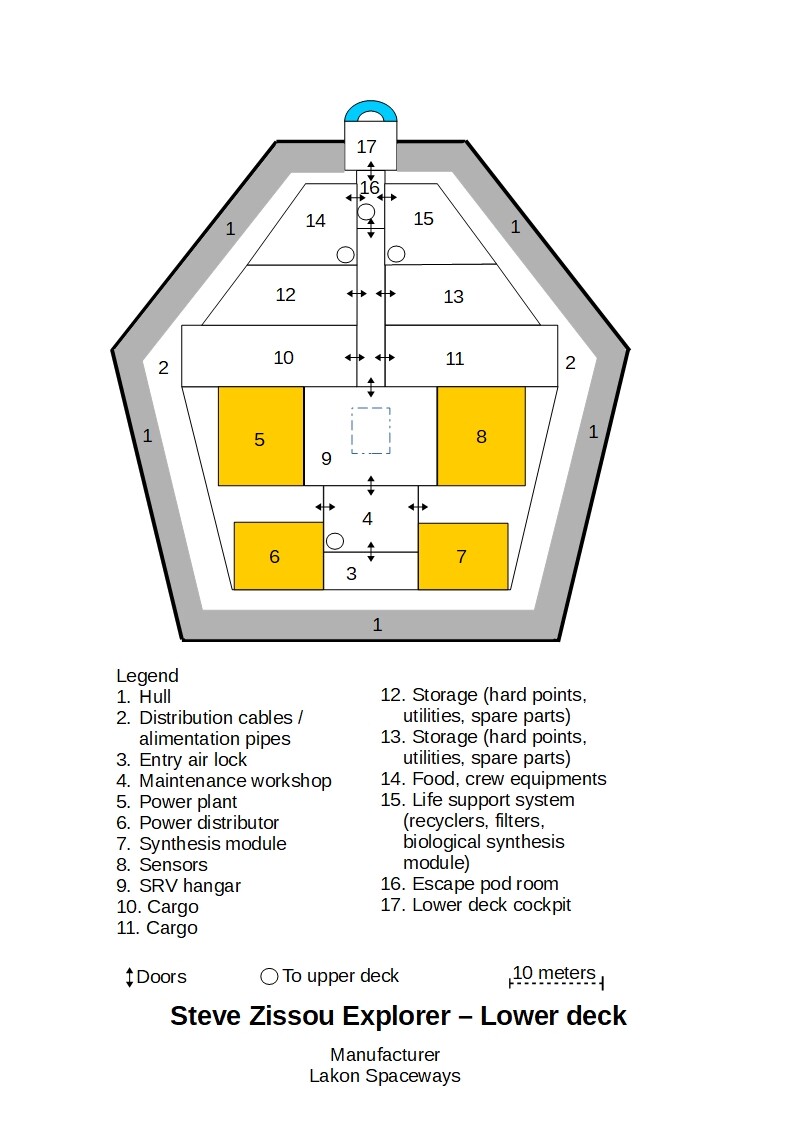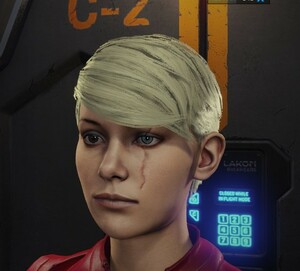The Steve Zissou Explorer part 1: the lower deck
14 Apr 2023Claude Lecardunoie
Five days, five busy days now that I have been stucked on Pru Euq IA-A d34 B 1.I was still on my exploration mission for Farseer Inc. I landed there on the 9th of april 3039, as the planet was promising in terms of raw materials to collect, especially yttrium in order to generate premium FSD injection. Always helpful while exploring. I did several SRV prospection surveys to find some chunks of it, with no success. Worse: one of the pressure cylinder of the SRV elevator appeared to be damaged, a reparation was necessary. And finally, the online navigation database I was using then had been taken off line. The independant pilots who had been running it deserve congratulations for their work, however, I had to a little bit of software configuration as the new tool I chose required a full installation on my vessel's central computer. I also took this time to do a maintenance inspection of the main modules my ship, the Steve Zissou Explorer.
The Steve Zissou Explorer is a Lakon Spaceways Asp XP: 2 decks, designed for a 2 crew members, 56.5m long, 51.3m large and 19.7m high. With a 3m thick hull plus another 3 to 3.5m wide false wall to accomodate all kind pipes, cables, pumps and valves. Removable panels, local digital panels and also safety electro-mechanical consoles in case of global computer malfunction are conveniently located to repair and pilot said pumps and valves.

Access airlock to the ship (3) is located at the stern. In addition of a set of several exo-suits, adpated to specific gravities and atmospheres, it has also a rack for weapons and personnal tools for on-foot exploration.
From there, going toward the bow, a door leads to the lower deck maintenance workshop (3). Various tools and a workbench allows simple, however at times, critical reparations. An accomodation ladder gives access to the upper deck, and three doors open, port, on the power room, starboard, on the sensors & synthesis module bay and ahead to the SRV bay.
In the power room, two core internal systems are located: the power plant itself (5) and the power distributor (6), connected to to alimentation cables running throughout the ship inside the fake walls.
The synthesis module (7), to be honest, I don't think I'll ever understand how this work. All I know is that it is manufactured by a Wreaken Corporation - Lakon Spaceways joint venture which tells a lot about its quality. Its little brother is embedded in my SRV to synthetise while on surface exporation. Next to the synthesis , in the same room is the Auger Vision sensors system (8).
The SRV bay (9), is a little bit oversized for the Scarabée, I think. But as an optional internal module, it has standard dimension in order to be easily swapped for another component. Yet, in the extra room, I stored SRV spare parts: tires, canopy, wheels etc.
The other door of the SRV hangar leads to a 2m wide corridor giving access to the other rooms of the lower deck.
First the cargo bays (10) and (11). Yes I took two cargo racks for an exploration. I don't know what I was thinking then, may be salvaging 10 tons of platinium. I would gladly swap it for an AFM module. However, they now contain 6 escape pods, so these cargo racks were a mistake, but a mistake that saved 6 lives. The racks are both connected to the hatch. The hatch itself has its own computer unit, in order to route the standard sized containers picked up while in space to the more relevant rack to ensure the ship general balance.
Moving along the corridor, 2 doors, left and right open to 2 storage rooms (12) and (13). They both contain various spare parts for the ship, gas containers, consumable for the utilities (chaff, heatsinks, shield cells) and ammunitions.
The last door, to the other end of the corridor opens on the lower deck escape room (16). Should the ship be evacuated, one of the 2 escape pods would be launched from here. A small weapon rack holds 2 hand guns. A ladder leads up to the upper deck.
The door, port side, accesses to the food, water and crew personnal equipment (clothing, anti-G suits) reserve (14). For the food, I packed basic injected nutrition fluids, protein gel portions, vitamin pills, but also synthetic meat and cereals, dehydrated vegetables. And finally, I have been lucky enough to pick up a food container on the first planet I explored, containing luxury goods, making this mission, at times, a gourmet tour.
(15) is the life support system room. Like in any other ship, it gives, in case of depressurization a minimum oxygen and pressure autonomy. But exploration ships, liners and generally big ships carry other systems: environmental control, filters, recyclers and a biological synthesis module. Again, for a better quality and safety for such a critical system, Lakon Spaceways contracted Hazardous Filtration Modules company. From this room, a drilling tool can even be deployed and controlled in order to break icy ground. Ice blocks can then be melted and filtered to replenish water reserves.
As mentioned above, the last door is the access to lower deck cockpit. Had I hired a crew member, that is were he would help me control the ship, but I didn't so it remains empty.
